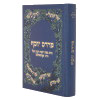


Highlighting: “Pardes Yosef,” By Rabbi Moshe Yosef Rubin. Shira-Mishor. 2021. Hardcover.
We are all familiar with the great rabbis of the last 250 years in countries such as Lithuania White Russia, Poland, Galicia and Hungary.
Yet Eastern European Jewry also had major settlements in places like the Ukraine, Bukovina Romania (Western area) and other areas.
The volume under review collects the writings and thoughts of a major 20th-century Romanian rabbinic figure who died in 1980.
Rabbi Rubin was a unique and interesting rabbinic figure, almost sui generis.
He was born as a scion of several well known chasidic dynasties including Belz, yet attended university in Romania and attained academic degrees, and even penned several monographs in Romanian.
Notwithstanding his chasidic and strictly Orthodox background, Rubin served as a communal rabbi in the important communities of Campulung and Iasy. In later years he was active in Bucharest in rescue efforts to save and ameliorate the conditions of the close to 400,000 Bukowinian Jews deported to the hell on Earth known as Transnistria.
Rabbi Rubin was a man of different colors: As mentioned, he was a chasidic rabbi, he was a first-class moreh hora’ah, decisor of halachic issues, but even more he was a community organizer, educator and preacher including sermonizing in the vernacular. He designed and built mikvaot and lectured on Judaism to the new wave of Jewish intelligentsia.
While it may seem odd to the modern reader, Rabbi Rubin was a devoted follower of the philosophy of Torah im derech eretz of Rabbi Samson Raphael Hirsch. He references Hirsch constantly. Little known to us is that Hirsch’s teachings had a strong influence on Orthodox Jewish life in Eastern Europe after the First World War.
This book, Pardes Yosef, is a collection of various writings of Rabbi Rubin in Hebrew, some translated from Yiddish and Rumaniano. He covers diverse subjects as Zionism, Judaism and economics, Communism, and we have many essays on the place of ethics and morality in contemporary Orthodoxy.
Although a loyal member of Agudath Israel, even being a member of the Rumanian Moetzet Gedolei HaTorah, he had a very positive and warm attitude toward the creation of a Jewish state prior to 1948 and was a devoted supporter of the State of Israel and saw the hand of Hashem in its creation and in events of the Six-Day War of 1967. Certain essays are clearly written with the intention of refuting the ideology if the Satmar Rebbe, Rabbi Joel Teitelbaum.
Following the end of the Second World War, the rav established the first post-war yeshiva in Eastern Europe, which was based in Bucharest and guided by the principles of Rabbi Samson Raphael Hirsch. The then-chief rabbi of Romania, Dr. Alexander Safran, acted as sponsor of this yeshiva.
Coming to the U.S. in the late 1940s, the rav served several Jewish communities as spiritual leader and was Av Beth Din of the Boro Park rabbinate for a number of years.
His crowning achievement after the war was his creation of Geder Avoth, Fence of our Fathers, the first organization dedicated to the maintainence of the Jewish cemeteries in Eastern Europe, which were in danger of disintegration or destruction due first to the Nazi regime and later the Communist regimes. Many of these cemeteries were in defunct communities with no caretakers; thus Rabbi Rubin led a multifaceted effort to save these sacred grounds and spawned a multiplicity of efforts dedicated to the same purpose.
Geder Avoth still is very active, directed by the rabbi’s grandson and publisher of this book, Mr. Moshe Y. Rubin of Monsey.
There is something for everyone in this book: drush on the parsha, Halacha, aggada, even rabbinic humor. The rav delighted in gematrios and was conversant in Kabbalah and chasidut.
An extensive biography details the rav’s life both in Romania and the U.S.
As mentioned, the rav relied on diverse inspirations for his drashot and ideas—men like Rabbi Hirsch, the Sigheter Rebbe and the Malbim. We see halachic exchanges with rabbinical greats like Rav Moshe Feinstein, Rav Henkin and the rav’s brother-in-law Rabbi Medhulam Roth, another Romanian rabbbinic great.
Rabbi Rubin even quotes some of his American contemporaries, such as Rabbi Samuel Baskin of the Bronx, whose son was the noted artist Leonard Baskin.
This volume in Hebrew will appeal to the historian and student of Halacha and aggadah.
We see before us a representative figure of the pre-war Romanian rabbinate, a true gadol, an ish ha’eshkolot, as Chazal tell us, ish shehakol bo, a man who is skilled in every discipline.
Zalman Alpert served as reference librarian in the Gottesman Library of Judaica at Yeshiva University from 1982-2014 and resides in New Haven, CT.













